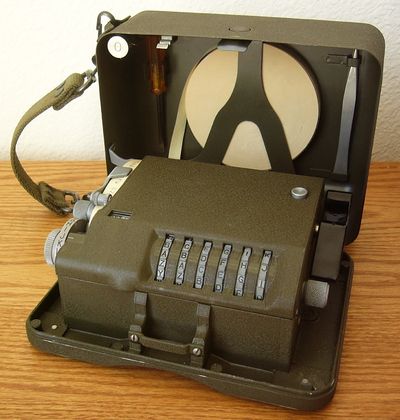Difference between revisions of "M-209"
RadioNerds (talk | contribs) |
|||
| (5 intermediate revisions by 2 users not shown) | |||
| Line 1: | Line 1: | ||
[[File:M-209.jpg|right|400px|M-209 Converter (NF6X)]] | [[File:M-209.jpg|right|400px|M-209 Converter (NF6X)]] | ||
| − | Converter M-209 is a small, compact, hand-operated, tape-printing mechanical device designed for rapid encipherment and decipherment of tactical messages which must be crypto-graphed before transmission. It is normally carried in a canvas case on a strap over the shoulder. the carrying strap may be attached underneath the machine for securing it to the knew of the operator when used in the field or in a moving vehicle. A hand strap is also provided which may be attached to the left side of the machine. | + | Converter M-209 is a small, compact, hand-operated, tape-printing mechanical device designed for rapid encipherment and decipherment of tactical messages which must be crypto-graphed before transmission. It is normally carried in a canvas case on a strap over the shoulder. the carrying strap may be attached underneath the machine for securing it to the knew of the operator when used in the field or in a moving vehicle. A hand strap is also provided which may be attached to the left side of the machine. The case has extra compartments for carrying the technical manual, pencils, extra tape, message blanks, etc. |
The cryptographic principle upon which the M-209 operated is that of reciprocal substitution alphabets. The effect is that of sliding a normal alphabet sequence against the same sequence reversed. A high degree of irregularity in the shifting of the alphabets with respect to each other is brought about by a train of gears in which the number of teeth on the driving member is varied under the influence of certain keying elements to be described in subsequent paragraphs. | The cryptographic principle upon which the M-209 operated is that of reciprocal substitution alphabets. The effect is that of sliding a normal alphabet sequence against the same sequence reversed. A high degree of irregularity in the shifting of the alphabets with respect to each other is brought about by a train of gears in which the number of teeth on the driving member is varied under the influence of certain keying elements to be described in subsequent paragraphs. | ||
| Line 11: | Line 11: | ||
::M-209 | ::M-209 | ||
::27 April 1942 | ::27 April 1942 | ||
| + | |||
| + | * [[File:SIG 7 8 M-209, Cg No 1.pdf]] | ||
| + | |||
| + | * [[File:SIG 7-M-209.pdf]] | ||
[[Category:Military/Radios/Accessories]] | [[Category:Military/Radios/Accessories]] | ||
| + | {{DISPLAYTITLE:M-209 Cipher Machine}} | ||
Latest revision as of 18:23, 11 May 2015
Converter M-209 is a small, compact, hand-operated, tape-printing mechanical device designed for rapid encipherment and decipherment of tactical messages which must be crypto-graphed before transmission. It is normally carried in a canvas case on a strap over the shoulder. the carrying strap may be attached underneath the machine for securing it to the knew of the operator when used in the field or in a moving vehicle. A hand strap is also provided which may be attached to the left side of the machine. The case has extra compartments for carrying the technical manual, pencils, extra tape, message blanks, etc.
The cryptographic principle upon which the M-209 operated is that of reciprocal substitution alphabets. The effect is that of sliding a normal alphabet sequence against the same sequence reversed. A high degree of irregularity in the shifting of the alphabets with respect to each other is brought about by a train of gears in which the number of teeth on the driving member is varied under the influence of certain keying elements to be described in subsequent paragraphs.
Related Files
- Technical Manual
- Converter
- M-209
- 27 April 1942
